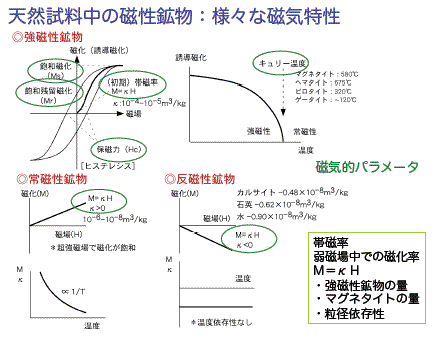- 主な単位系は次のとおり。①
・CGS電磁単位系(CGS-emu)
emu=electromagnetic unit(電磁単位)
・CGS静電単位系 (CGS-esu)
esu=electrostatic unit(静電単位)
・CGSガウス単位系 (ガウス単位系)
・ヘヴィサイド・ローレンツ単位系(ヘヴィサイド単位系)
・実用単位系 (practical units) /BA単位系 (British Association units)
・MKSA単位系
導磁率
- 磁場(磁界)の強さHと磁束密度Bとの間の関係を
B=μH で表した時の比例定数μである。単位はH/m(ヘンリー毎メートル)、あるいは
N/A2(ニュートン毎平方アンペア)。
磁界の強さHと磁束密度Bとの関係、磁化曲線またはB-H カーブの傾きになる。実用的な強磁性磁気材料では、磁化曲線はヒステリシスをもつので、透磁率は始め小さく(初透磁率)、その後大きくなる。
透磁率の大きい材料を芯につかえばより強力な電磁石になる。
真空の透磁率μoとの比μs=μ/μoを比透磁率という。
μo=4π×10-7H/m=1.2566370614…×10-6H/m
真空中の誘電率εoと真空中の光速cとの間には
√εoμo=1/c
という関係がある。①
- 磁気双極子モーメント、簡単には磁気モーメントM は、一対の磁荷としても一つの環状電流としても定義できる。
一対の磁荷として定義するなら、磁荷の大きさをm 、正負二つの磁荷を距てる無限小の距離ベクトルをl、とすると、磁気モーメントM は
M = ml
で与えられる。
一方、環状電流として定義するなら、環の面積をA 、電流をIとすると、
M = IAn
となる。ここで、n は環と垂直な単位ベクトルである。nの方向、したがってMの方向、は右手の法則によって与えられる。すなわち、電流の方向に右手の親指以外を巻いたときに親指の方向がnの方向になる。
環電流で磁気モーメントを定義するのは、磁気モーメントはすべて電流によっているのであるから、より基本的である。しかし、磁気モーメントが磁荷の対からなっていると考えた方が便利なこともある。②
磁気分極
- 磁性体に外部磁場をかけたときに、その磁性体が磁気的に分極して磁石となる現象のこと。また、磁性体の磁化の程度を表す物理量も磁化と呼ぶ。磁気分極(magnetic
polarization)とも呼ばれる。
強磁性体は磁場をかけて磁化させた後に磁場を取り除いた後も分極が残り永久磁石となる残留磁化と呼ばれる現象があるが、これも磁化と呼ぶ場合がある。① - 磁化Jと帯磁率χ
ある物質の磁石の強さあるいは磁化Jは単位体積あたりの磁気モーメントの量である。ある体積の磁化の大きさを計算するには、磁気モーメントのベクトル和を体積で割ればいい。
J =ΣMi/体積
Mi というのは構成している磁気モーメントである。磁化の強さの単位はT(テスラ)またはWb/m2。磁化は誘導磁化と自発磁化の二つに分類できる。ある物質が磁場H にさらされると、誘導磁化Jiが生じる。生じる磁化と磁場は帯磁率χで結びつけられる。
Ji=χH
つまり、帯磁率χはある物質の磁化しやすさと見ることができる。上の式では帯磁率としてスカラーを取った。これは磁化と磁場が平行となることを暗黙に仮定していることとなる。しかしながら、磁気異方性を示す物質もある。そのような物質ではJi はH と平行にはならない。磁気異方性を持った物質では、x方向に磁場をかけても一般にはx方向だけではなくy, z方向の磁化も生ずる。この様な場合は、帯磁率は3×3 の行列で表されるようなテンソルとなる。現在の磁場の働きかけの結果である誘導磁化に加えて、残留磁化Jrを持つ物質もある。残留磁化はその物質に働いた過去の磁場を記録している。②
- 自然残留磁化(NRM)③
J=Ji+Jr
Ji:誘導磁化、Jr:自然残留磁化。
Ji=χH
H:地球磁場、Ji:誘導磁化。
NRM=初生NRM+二次NRM
初生NRM=熱残留磁化(TRM)+化学残留磁化(CRM)+堆積残留磁化(DRM)。
二次NRM=粘性残留磁化(VRM)+等温残留磁化(IRM)。 - 飽和等温残留磁化(SIRM)、S-0.3T=[1-(IRM0.3T/SIRM)]/2〔0.3Tは大部分の磁鉄鉱のIRMが飽和する磁場〕、S ratio、HIRM〔=SIRM+IRM-0.3T)/2〕、非履歴性残留磁化(ARM)④
磁気感受率
- 体積磁化率:κ=M/H
H:磁場(A/m)、M:単位体積当たりの磁化(A/m)②
- 質量磁化率:χ=κ/ρ
κ:体積磁化率(無次元)、ρ:密度(kg/m3)②
/Image331.gif)
- 磁気ヒステリシス②
強磁性体においては、その磁化は加えた磁場に比例せず、ヒステリシスを示す。
ヒステリシスループの形は磁性体の性質によって違う。
O→B→C:初磁化曲線
C→D: 残留磁化:飽和等温残留磁化(SIRM)
D→E: 保磁力
C→D→E→F→G→C:ヒステリシスループ
κ:初生帯磁率
Hc:保磁力
Hcr:残留保磁力
Ms:飽和磁化
Mrs:飽和残留磁化 - Day plot、ORC(First-order reversal curves) diagrams④
抗磁力
キュリー点
Curie point
magnetic ordering temperature
- 反強磁性体が常磁性へと転移する温度。①
- The Neel(最初のeの頭に´) temperature or magnetic ordering temperature, TN, is the temperature above which
an antiferromagnetic or ferrimagnetic
material becomes paramagnetic-that
is, the thermal energy becomes large enough to destroy the macroscopic
magnetic ordering within the material.
The Neel(最初のeの頭に´) temperature is analogous to the Curie temperature, TC, for ferromagnetic materials. It is named after Louis Neel(最初のeの頭に´)(1904-2000), who received the 1970 Nobel prize in physics for his work in the area.①
- Fe-フェライトは磁鉄鉱(magnetite)と呼ばれ、人類が発見した最も古い磁性体である。スピネル格子で、単位胞の中に32個のO2-イオンと8個のAイオンと16個のBイオンの計56個のイオンを含む。磁鉄鉱はBイオンにFe3+とFe2+が同居するため、それらの間を電子が飛び移るホッピング伝導を行う。そのため、フェライトの中では異例に電気抵抗率が低い。125Kでこのホッピングは停止し、その温度以下で電気抵抗は急上昇し、結晶がひずむ。この変態点をフェルベー点という。②
- ヘマタイト(α-Fe2O3)は低温(250K以下)ではc軸方面に磁化を持つ反強磁性であるが、高温(250-963K)ではc面に磁化を持つ傾角磁性になる。この250Kの転移点をモーリン点という。②
- The Morin transition (also known as a spin-flop
transition) is a magnetic phase transition in α-Fe2O3 hematite where the antiferromagnetic ordering is reorganized
from being aligned perpendicular to the c-axis to be aligned
parallel to the c-axis below TM.
TM = 260K for Fe3+ in α-Fe2O3.
A change in magnetic properties takes place at the Morin transition temperature.①
段階的に、磁場の大きさあるいは温度を変えて、磁化を測定することにより、磁性鉱物の種類(化学組成の違いも含む)や量や粒径を予想する。
- 部分消磁-段階消磁③
交流消磁
熱消磁
化学消磁
SI=国際単位系、cgs=cgs単位系。
T=テスラ、G=ガウス、Oe=エルステッド、H=ヘンリー、A=アンペア、m=メートル。
- ①ウィキペディア(Wikipedia)。
- ②いろいろなメモ(岩石磁気の基礎の基礎)(HP/2013/11) http://staff.aist.go.jp/r-morijiri/memomemo/misc00.html
森尻理恵氏による。 - ③古地磁気学 http://www.sci.kumamoto-u.ac.jp/earthsci/shibuya/ButlerJ0.1.7.3.pdf
Robert F. Butler著(1992)の渋谷秀敏氏による訳。2001年7月、139p。 - ④環境磁気学―レビュ― https://www.jstage.jst.go.jp/article/jgeography1889/114/2/114_2_284/_pdf
鳥居雅之氏による。地学雑誌、114(2)〔特集:地磁気・古地磁気研究の最前線〕、284-295、2005年、12p。
/Image271.gif)
/Image287.gif)
/Image286.gif)

/Image288.gif)
/Image289.gif)
/Image290.gif)
/Image291.gif)
/Image292.gif)
/Image293.gif)
/Image320.gif)
/Image319.gif)
/Image104.gif)
/Image105.gif)
/Image106.gif)
/Image325.gif)
/Image326.gif)
/Image327.gif)
/Image328.gif)
/Image329.gif)
/Image330.gif)
/Image243.gif)
/Image246.gif)